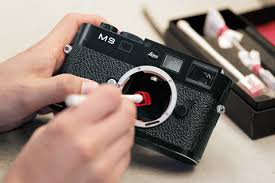Replaced Leica M9 Image Sensor
writer: russell j.t. dyer; posted: feb 2017; revised: apr 2018
Digital cameras will sometimes accumulate dust on their image sensors. You can use a duster blower, a rubber bulb that you squeeze, to blast the sensor with air — never touch a sensor with your finger. A duster bulb works well most of the time. Some cameras have an electronic method for removing dust that a blower can’t remove. If the dust won’t dislodge from the sensor by one of these methods, you’ll have to clean the image sensor using a special tool that looks like a small piece of sticky candy on the end of a stick. You just dab lightly the sensor in a methodical pattern to remove dust. It’s easy to do, but it’s even easier to damage irreparably the sensor. So it’s generally better to have a professional repairman do it for you.
Starting about a year ago, images taken with my Leica M9 camera have had spots on them caused by what I thought was dust on the image sensor. I tried using a duster blower, but it didn’t resolve the problem. I was able to remove the spots from images in Adobe Photoshop, but it’s bothersome to do it for every photo — especially when there are so many. Plus, sometimes the larger spots appeared on key parts of an image, such as on the eyes or face of a model. That makes it difficult to remove them in post production.
A few weeks ago, I brought my camera to the Leica store in Milan, near where I live, to have them clean the image sensor — they do that for free. They kept my camera a few days and then told me the image sensor needed to be replaced. They then sent my camera to Leica in Wetzlar, Germany — they didn’t change me for the shipping cost either.
A couple of weeks later I received an email saying that they confirmed that the image sensor did need to be replaced and that they would replace it for free — which was very cool. They replaced the image sensor and returned the camera to the Leica store in Milan about a week later for me to get from there.
There were two letters accompanying the camera. One was entitled Delivery Note — that is to say, in Italian since they assumed I was Italian. It mentioned working on the camera to include updating the firmware, adjusting the rangefinder, and cleaning. The second letter included in the package was entitled, Repair Invoice. On that one it says that the sensor was replaced and I was charged nothing. Below are snippets of the invoice — I removed personal and unrelated information. It’s written in Italian, but it says what I recounted in this paragraph.
The camera is in great shape now. They cleaned it throughly, lubricated all of the moving parts and calibrated the rangefinder (i.e., the focusing apparatus). With all of that work and the new image sensor, it’s like a new camera. Best of all, it cost me nothing. After spending so much on repairing my Leica M3 camera and getting Leica to encode and repair two of my lenses, it’s nice to get one repair done for free. This is a camera that was made in 2011, that I bought used from KEH Camera in March of 2014. So it’s past it’s warranty and I’m not the original owner. Yet, they replaced the image sensor for free.
This isn’t them doing me in particular a favor. Instead, it’s a special image sensor replacement program Leica started in September 2015:
We are very pleased to inform you that we have successfully completed development on our new generation of CCD sensors and conducted subsequent quality assurance testing under practical conditions. As a result, Leica Camera AG can now begin replacing the sensors in the M9, M9-P and M-E models that were affected by corrosion with sensors from the new generation.
From reading that, it sounds like the new image sensor is an improvement and will last longer. Plus, a new image sensor would probably cost about 500 euros, but cost me nothing. So, thank you Leica.

